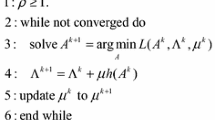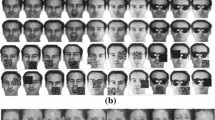Abstract
We introduce a sparse region selection problem and an effective solution algorithm where one seeks for a small subset of points in a two-dimensional plane (e.g., image) that are considered to be the most important. Its direct application is the face recognition in machine vision in which we aim to find a group of key pixels in a facial image that are the most salient in discriminating subjects from others. Sparseness plays a key role in enhancing the prediction performance since observed data often contain considerable amount of noise potentially. In addition to the sparseness constraint, the active features need to be spatially coherent so as to form meaningful contiguous areas, not just random scatters. We formulate the problem and approximate it as convex optimization with nonnegative L1 constraints, where we introduce an efficient solution method that modifies the gradient Lasso algorithm that was previously used for solving convex problems with L1 constraints. We demonstrate that the proposed approach not only yields superior prediction performance to the existing methods on several real-world benchmark face datasets, but also discovers regions around the key facial features such as eyes/eyebrows and nose/mouth that are widely believed to be important for face recognition.






Similar content being viewed by others
Notes
In this paper we assume that the face images are well aligned to one another.
In the notation, ||A||2 is L2 (Euclidean) norm if A is a vector whereas it is the spectral norm (i.e., the largest eigenvalue) of A if A is a matrix.
References
Belhumeur P, Hespanha J, Kriegman D (1997) Eigenfaces vs. Fisherfaces: recognition using class specific linear projection. IEEE Trans Pattern Anal Mach Intell 19(7):711–720
Belkin M, Niyogi P (2003) Laplacian Eigenmaps for dimensionality reduction and data representation. Neural Comput 15(6):1373–1396
Censor Y, Zenios S (2002) Parallel optimization: theory, algorithms, and applications. Oxford University Press, London
Chung FRK (1996) Spectral Graph Theory. CBMS Regional Conference Series in Mathematics, No. 92. American Mathematical Society
d’Aspremont A, Ghaoui LE, Jordan M, Lanckriet G (2007) A direct formulation of sparse PCA using semidefinite programming. SIAM Review 49(3):434–448
Donoho DL, Tanner J (2005) Sparse nonnegative solutions of underdetermined linear equations by linear programming. In: Proceedings of the national academy of sciences, pp 9446–9451
Duda RO, Hart PE, Stork DG (2001) Pattern classification. Wiley, New York
Efron B, Hastie T, Johnstone I, Tibshirani R (2004) Least angle regression. Ann Stat 32(2):407–499
Georghiades AS, Belhumeur PN, Kriegman DJ (2001) From few to many: illumination cone models for face recognition under variable lighting and pose. IEEE Trans Pattern Anal Mach Intell 23(6):643–660
Goldberger J, Roweis S, Hinton G, Salakhutdinov R (2005) Neighbourhood components analysis. In Advances in Neural Information Processing Systems
Jolliffe IT (1986) Principal component analysis. Springer, New York
Jolliffe IT, Trendafilov NT, Uddin M (2003) A modified principal component technique based on the LASSO. J Comput Graph Stat 12(3):531–547
Kim J, Kim Y, Kim Y (2008) A gradient-based optimization algorithm for LASSO. J Comput Graph Stat 17(4):994–1009
Kim SJ, Koh K, Lustig M, Boyd S, Gorinevsky D (2007) An interior-point method for large-scale l1-regularized least squares. IEEE J Sel Top Sig Process 1(4):606–617
Kim Y, Kim J (2004) Gradient lasso for feature selection. In: Proceedings of the 21st international conference on machine learning, pp 60–67
Lee H, Battle A, Raina R, Ng AY (2007) Efficient sparse coding algorithms. Advances in Neural Information Processing Systems (NIPS) 19
van der Maaten L (2011) Learning discriminative Fisher kernels. International Conference on Machine Learning
Martinez AM, Benavente R (1998) The AR face database. CVC Tech Rep:24
Nesterov Y (2005) Smooth minimization of non-smooth functions. Math Program 103(1):127–152
Savvides M, Abiantun R, Heo J, Park S, Xie C, Vijayakumar B (2006) Partial and holistic face recognition on FRGC-II data using support vector machine kernel correlation feature analysis. In: Proceedings of conference on computer vision and pattern recognition (CVPR) workshop
Schölkopf B, Smola A (2002) Learning with kernels. MIT Press, Cambridge, MA
Sinha P (2006) Face recognition by humans: Nineteen results all computer vision researchers should know about. In: Proceedings of the IEEE, pp 1948–1962
Turk M, Pentland A (1991) Face recognition using eigenfaces Proceedings IEEE conference on computer vision and pattern Recognition. Maui, Hawaii, pp 586–591
Wright J, Yang AY, Ganesh A, Sastry SS, Ma Y (2009) Robust face recognition via sparse representation. IEEE Trans Pattern Anal Mach Intell 31(2):210–227
Yuan X, Zhang T (2013) Truncated power method for sparse eigenvalue problems. J Mach Learn Res 14:899–925
Acknowledgments
This study is supported by National Research Foundation of Korea (NRF-2013R1A1A1076101).
Author information
Authors and Affiliations
Corresponding author
Rights and permissions
About this article
Cite this article
Kim, M. Sparse discriminative region selection algorithm for face recognition. Appl Intell 42, 817–828 (2015). https://doi.org/10.1007/s10489-014-0636-8
Published:
Issue Date:
DOI: https://doi.org/10.1007/s10489-014-0636-8




